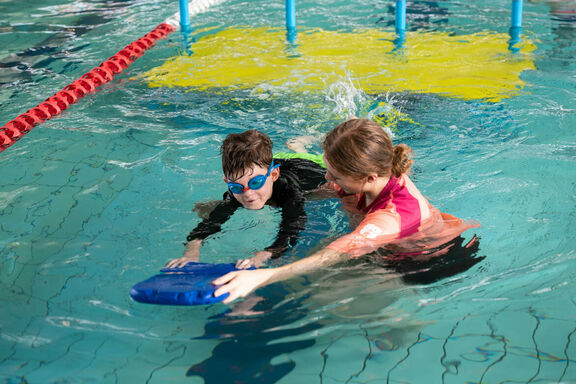- Vision
- Hearing
Summer’s a great time to get out in the water. But with drowning a leading cause of accidental death for young children in Australia, it’s important to know how you can help your child who is deaf or hard of hearing, is blind or has low vision, stay safe in the water.
Danae and Kellie, teachers at NextSense School, have put together a list of top safety tips for parents of kids who are keen to hit the pool or sea.

1. Enrol your child in regular swimming lessons
Swimming lessons enhance children’s water safety knowledge, further their skills, help keep them fit and boost confidence. Best of all, lessons are subsidised by the government in many states and territories.
It’s important to choose a swim school or instructor that is right for your child and is open to using alternative communication methods if needed. Deaf awareness training is currently available through the Puggles Swim Course and is a great way to upskill instructors.
Each year, some of our NextSense School students, who have hearing or vision loss, undertake an intensive swim program and say it’s the highlight of their year. Teachers ensure everyone gets the most out of the program by providing a quiet and calm environment, and using clear gestures and visual cues for students who are deaf or hard of hearing. We also have an Auslan interpreter on hand and work individually with our students who are blind. You can check out some photos on our Instagram page.

2. Keep hearing devices safe and dry
For kids who have cochlear implants, being in the water doesn’t have to mean losing access to sound.
There is a range of watertight accessories available to help keep cochlear implant processors dry and hold them in place when swimming. Ask your audiologist about options for your child’s device.
If their hearing device can’t be worn in the water or they prefer not to use them while swimming, ensure they are kept safe and dry by using a watertight dry box.
Image: Cochlear Americas

3. Make sure your child is close to you at all times
An experienced sighted swimmer should be within arm’s length of a child who is blind or has low vision in open water at all times to ensure help is at hand if needed.
For parents of children who are deaf or hard of hearing, having your child close to you will also allow them to read your lips or see you signing more easily.

4. Teach key swimming-related vocabulary and signs
Having a bank of water-related words and signs such as ‘no diving’, ‘shallow’, ‘deep’, ‘beach’ and ‘flags’ will make communicating with your child while in the water easier.

5. Teach your child to watch lifeguards or lifesavers and know what to do if they need help
If possible, let lifeguards and lifesavers know that your child has hearing or vision loss before they get in the water, so they are aware of any adjustments they can make to their communication methods in case of an emergency.
